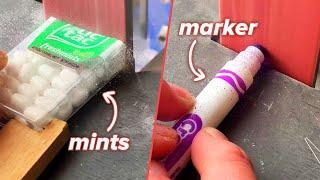
What's the Best Mix for Perfect Rendering?
So, what's the best mix for rendering?
It all depends on what you're rendering on to.
The golden rule is you never make the mix stronger than the material that you're going on to. For example, lightweight concrete block that's 3.6kN, so we don't want a really strong mix for this because if the wall moves, which it will as you always get some expansion and contraction as the seasons change, you don't want the render to be the thing that stops the wall from moving otherwise the render will crack. If you've ever wondered why render cracks, often this is a reason. Also if you put too much cement in the render it shrinks back and it will crack. People don't always believe that, lots of people do a 3:1 mix and say it's nice and strong but that won't stop it from cracking because there's no real tensile strength in it so there's no point putting too much cement in.
Why lime helps make the best mix for rendering
Instead, we make a 6:1:1, which is six parts of sand, one part of cement and one part of hydrated lime. The sand must be plastering sand or rendering sand, not building sand - do not use building sand for rendering because it shrinks and cracks. Sometimes you can add some building sand to the mix for the base coat, but it shouldn't be your primary sand. It's important not to put more than one part lime to one part cement because hydrated lime won't set on its own, you need the cement to help it set. But the lime does give the mix body and make it creamy and gives it a certain amount of elasticity so that if the building moves the render will go with it a bit and if you do get a crack the lime in the mix will move into the crack and re-calcify to some extent. In a way it is self curing and self-rendering. A lot of renderers don't use it and prefer to use plastisier which puts lots of bubbles into the mix which is a good thing but the lime is better as we demonstrate in this video.
Roger also discusses the best weather for rendering.
===================================================
#rendering #homeimprovement #diy
🔗 Skill Builder Link Tree: https://linktr.ee/skillbuilder
👍 Tell us what you like: http://skill-builder.uk/vote
📪 Newsletter Signup: http://skill-builder.uk/signup
🎥 TikTok: https://www.tiktok.com/@skillbuilder
📖 Facebook: https://www.facebook.com/skillbuilderchannel
📷 Instagram: https://www.instagram.com/skill_builder
🛒 As an Amazon Associate, we earn from qualifying purchases
🎬 All videos: https://www.youtube.com/skillbuilderchannel/videos
💧 We Support Charity Water: https://www.charitywater.org
◾ Out of respect to our channel sponsors and the wide variety of people who watch our videos, we'll remove comments that do not follow common standards of politeness and decency.
Тэги:
#rendering_mix #render_mix #perfect_render_mix #rendering_mix_ratio_external #rendering_mixture #render_mix_ratio #render_mix_ratio_for_external_walls #how_to_mix_render #render_mixture #sand_and_cement_rendering_mix #rendering_mix_ratio #render_mixture_ratio #rendering #how_to_mix_cement_render #how_to_mix_mortar #sand_and_cement_rendering_techniques #sand_and_cement_rendering #how_to #sand_and_cement #lime_render #stucco #rough_cast #k_rend #lime_mix #how_to_mix_cementКомментарии:

Bravo.
Ответить
Hydrated lime DOES set. Used it at 1:2 with sharp sand for flintwork. Still good 2 decades later.
Also used it for render and plaster.

Thanks!
Ответить
65 years ago when I began to serve my time one of the first things I was told as a right hander,always work from left to right. You usually can spot a plasterer by how he uses his hardboard and TROWEL,it's never called a float. A float is made from straight grain wood(yellow pine if possible).
Ответить
Roger’s the man 👍🏻
Ответить
You put 1 coat... Is that enough? Here we can buy a render for outside for first rough coat and then 2.coat fine coat..
Ответить
good tip man
Ответить
In fact lime will set, its called carbonation and thats how limestone was made in the first place. lime needs a fair amount of time to set though, approx. 1 year per 1cm of depth. in the early years people plastered only with lime and no cement, im doing that as well, you just have to be careful with the render in the beginning to not scratch it.
Ответить
Horse mind ur trowel
Ответить
Can you do a video on Brick Slips Pros and Con of it. To be used on the external of the building
Ответить
You are a fantastic help Roger.
Do you ever consider using a hydraulic lime as an additional binder to your sharp sand based mix?
I always find my void ratio in a sand ( its a simple process)
Sharp sand will generally have enough void to acomadate 1 binder to 2.5 or 3 units of aggregate.
6:1:1 is therefore a very good mix.
Although my work is mainly brickwork the mix rule is generally the same.
What are your thoughts on scud coats on celcon type blocks 1st?

thanks mate! Top tips before my DIY disaster
Ответить
Wow ...its like quantum physics
Ответить
Hat hawk float hahahahhah
Ответить
Can you have lime in the scratch coat (sand, cement and lime) and if so what ratio for the scratch coat and what ratio for the top coat please?
Ответить
Really useful practical demonstration on external rendering and the dangers of using an overly strong material.
Further technical guidance on rendering can be found Building Research Establishment publication “Good Building Guide No 18” (Choosing external rendering) as this provides authourative information, including clarifying suitable preparation options, appropriate mixes for different backgrounds and exposure levels, and examples of good detailing. It might be also be worth bearing in mind that strong mixes (and plastic paints) inhibit evaporative drying and can trap moisture.

On a single skin shed wall would you use Lime AND water proofer?
Ответить
Thank you Roger
Ответить
Hello Roger, I do like the way you put things across on your videos, always makes a lot of sense. I need to patch a couple of sq, meters of fine textured render on a wall . I will be taking it down to bare (old brick) What materials do I need to carry out this task in the most simple way as I have not done this particular job before? Or can you buy it in a bag ready mixed ? Regards David.
Ответить
2023:
"Scientists discover self repair capacity in ancient roman caementum"😃


























